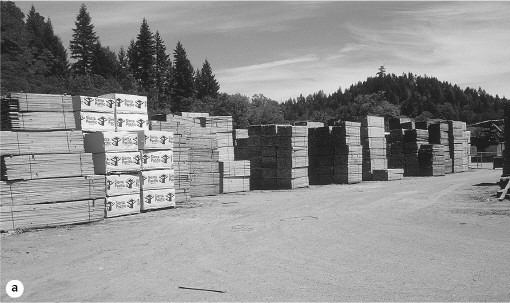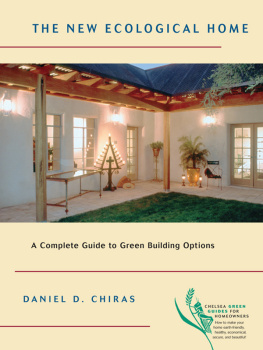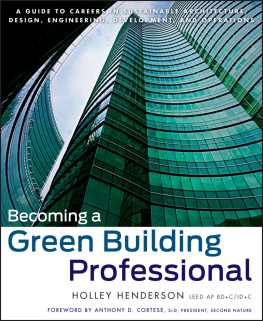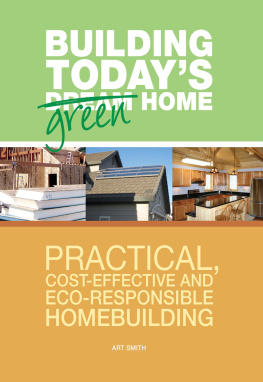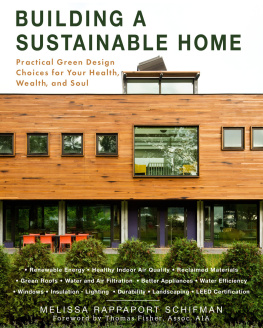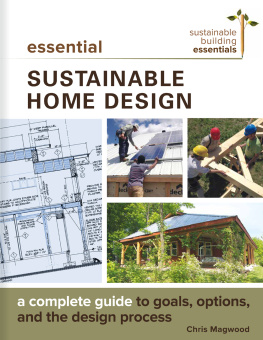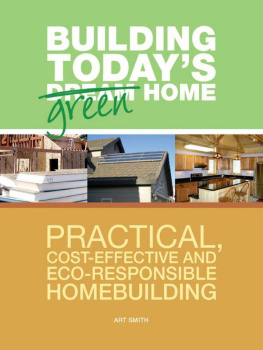
THE NEW ECOLOGICAL HOME
Selected Titles by the Author
The Solar House: Passive Heating and Cooling (Chelsea Green)
Superbia! 31 Ways to Create Sustainable Neighborhoods (New Society Publishers)
The Natural House: A Complete Guide to Healthy, Energy-Efficient,Environmental Homes (Chelsea Green)
The Natural Plaster Book: Earth, Lime, and Gypsum Plasters forNatural Homes (New Society Publishers)
Lessons from Nature: Learning to Live Sustainably on the Earth (Island Press)
Beyond the Fray: Reshaping Americas Environmental Response ( Johnson Books)
Voices for the Earth:Vital Ideas from Americas Best EnvironmentalBooks ( Johnson Books)
Environmental Science: Creating a Sustainable Future, 6th ed.
( Jones and Bartlett)
Natural Resource Conservation: Management for a Sustainable Future, 9th ed. (Prentice Hall)
Human Body Systems: Organization and Structure ( Jones and Bartlett)
Human Biology: Health, Homeostasis, and the Environment, 4th ed. ( Jones and Bartlett)
Biology:The Web of Life (West)
Essential Study Skills (Brooks-Cole)
THE NEW ECOLOGICAL
HOME
The Complete Guide to Green Building Options
DANIEL D. CHIRAS
Chelsea Green Publishing Company
White River Junction, Vermont
Copyright 2004 by Daniel D. Chiras
All rights reserved.
No part of this book may be transmitted in any form by any means without permission in writing from the publisher.
Chapters 10 and 11 of this book were adapted with permission from articles published in Mother Earth News.
Designed by Peter Holm, Sterling Hill Productions
Printed in the United States of America
First printing, March 2004
10 9 8 7 6 5 4 3
Printed on acid-free, recycled paper
Library of Congress Cataloging-in-Publication Data
Chiras, Daniel D.
The new ecological home : a complete guide to green building options / Daniel D. Chiras.
p. cm.
Includes bibliographical references.
eBook ISBN: 9-781-60358-084-7
1. Ecological houses. 2. Architecture and society. 3. Green
products.
4. DwellingsEnergy conservation. I.Title.
TH4860.C45 2004
690'.8dc22
2004000103
Chelsea Green Publishing Company
Post Office Box 428
White River Junction,VT 05001
Editorial and Sales offices: (802) 295-6300
To place an order: (800) 639-4099
www.chelseagreen.com
To the pioneers of green building, who have given this movement lifeand continue to contribute tirelessly to the creation of a sustainablefuture, one building at a time...
CONTENTS
I am deeply indebted to the numerous people who have aided me in the preparation of this book, answering questions, sending information, or simply steering me in the right direction. A great many thanks to Alex Wilson (BuildingGreen), David Johnston (Whats Working), Randy Udall (CORE), David Adamson (EcoBuild), Ron Judkoff (NREL), Chuck Kutscher (NREL),Brian Parsons (NREL),Kristin Shewfelt (McStain Neighborhoods), Doug Schwartz (Grayrock Commons Cohousing), Debbie Behrens (Highline Crossing Cohousing), Jay Scafe (Terra-Dome), Brad Lancaster (Drylands Permaculture Institute), Cedar Rose Guelberth (Building for Health Materials Center), Greg Marsh (Gregory K. Marsh and Associates), Doug Hargrave (SBIC), John and Lynn Bower (The Healthy House Institute), James Plagmann (HumanNature), Doug Seiter (NREL), Jennie Fairchild (P.A.L. Foundation), Marcus von Skepsgardh (P.A.L. Foundation), Samantha McDonald (Spatial Alchemy), Charles Bolta (American Environmental Products), Bill Eckert (Friendly Fire), Niko Horster (Chelsea Green), Bruce Brownell (Adirondack Alternate Energy), Heinz Flurer (Biofire), Vashek Berka (Bohemia International), and Doni Kiffmeyer and Kaki Hunter (OK OK OK Productions).Thanks also to the many individuals and companies who unselfishly provided photos for this work.
I am also grateful to my colleagues at Chelsea Green: Jim Schley, who helped me early on to shape this book and focus it on the right audience; my copyeditor, Alan Berolzheimer, for helping refine the manuscript; and Collette Fugere, who ushered this book through production.
I owe a huge debt of gratitude to my two sons, Forrest and Skyler, for their love and affection and constant good humor. As always, you help me maintain my perspective on whats important. Finally, I owe many thanks to my partner, Linda, for her patience, understanding, kindness, and unwavering love and support.
S helter is one of the most basic of all human needs, rivaling water, food, and clothing. It safeguards us from foul weather and shields us from sweltering heat and oppressive humidity.Without it, human survival in the diverse and sometimes harsh climates we inhabit would be difficult, if not impossible.
But shelter offers more than protection. It serves as the nucleus of our family life. It is here that we and our loved ones share our lives, grow, and celebrate lifes victories and mourn intermittent defeats. Although not always a respite from the hectic pace of modern life, our homes can provide peace, solitude, and a place for reflection and quiet contemplation.
Shelter is also a financial investment that can reap huge economic rewards. And in many countries, providing shelter is big businessvery big business. According to the U.S. Department of Commerce Bureau of the Census, newly built single-family homes, duplexes, condos, townhouses, and apartments constructed in 2002 were worth an estimated $389 billion! Hundreds of thousands of jobs, from forest managers, lumberjacks, and truck drivers to framers, carpet installers, and painters, are created by the massive homebuilding industry.
However, shelter, like many other elements of human existence, comes at an extraordinary cost to the planet and its inhabitants. For example, construction of the 1.2 million new homes annually in the United States results in a massive drain on the Earths natural resource base. Consider our forest-lands. In the United States, 85 percent of all new homes are framed with wood.Wood is used elsewhere in construction, too, for instance, to manufacture exterior sheathing, doors, and floors.Today, nearly 60 percent of all timber cut in the United States is used to build houses (Figure 0-1 a & b).
According to the National Association of Home Builders, a typical 2,200square-foot home requires 13,000 board feet of framing lumber:two by fours, two by sixes, and larger dimensional lumber. If laid end to end, the framing lumber required to build an average-sized new home would stretch two and a half miles. If all the dimensional lumber used to build these 1.2 million new homes constructed in the United States each year were laid end to end, it would extend 3 million milesto the moon and back six and a half times.
Many other countries also rely heavily on forests for wood. Humankinds massive demand for timber results in extensive tree cutting. In many regions, timber harvesting is carried out with little concern for the environment. Trees are clear-cut and the land is laid bare, often on an enormous scale. Massive deforestation, in turn, results in a long string of environmental problems: soil erosion, sediment pollution in nearby streams, loss of wildlife habitat, and species extinction (see ).
